Devices
This menu displays the possible payloads/devices that can be configured with Veronte Autopilot 1x. Each panel will allow the user to configure different parameters from the available variety of payloads.

By default, only the Transponder/ADS-B device is added to this menu (as shown in the figure above). However, users can add other devices supported by Veronte Autopilot 1x simply by clicking Add device:
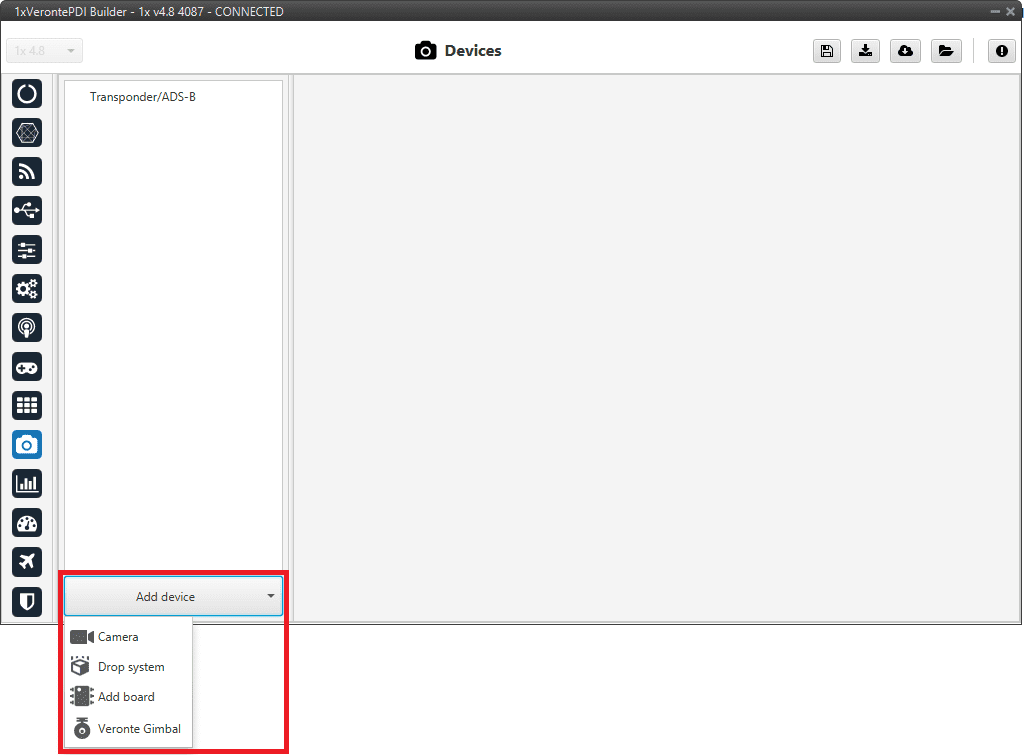
Transponder/ADS-B
A transponder is a device that generates or parses ADS-B messages. This menu allows the user to use/configure a transponder through Custom Messages.
The interface includes different transponder models, depending on the one selected, some configurable parameters are enabled or disabled.
Important
To configure the Squawk Code, enable/disable Ident Mode and select the "dynamic" ADS-B Out mode, users must use the ADS-B widget of Veronte Ops. For more information on this, please refer to ADS-B - Flight instruments widgets of the Veronte Ops user manual.
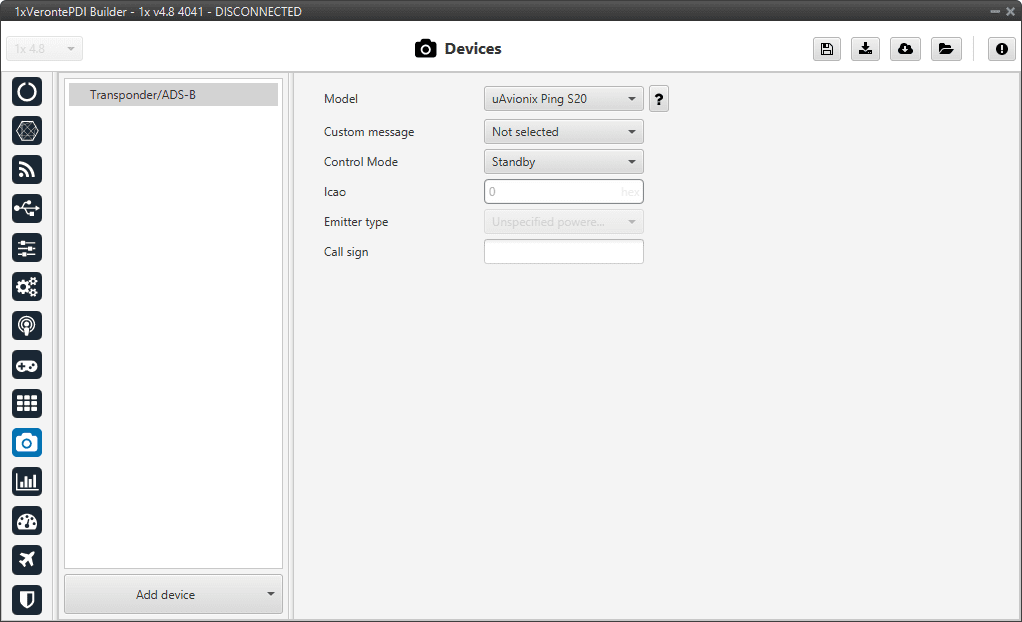
The parameters that appear in this menu and that must be configured by the user depending on the transponder model are explained below:
-
Model: The options available in Veronte Autopilot 1x are as follows:
- Internal Transponder
- uAvionix Ping 20s
- uAvionix Ping 1090
- Sagetech MX Series
- Sagetech XPS-TR
- Sagetech XPG-TR
- Sagetech XPS-TRB
- Daedalean
- Internal Remote ID
By clicking on the
 button next to the drop-down menu, an "information" dialog window about the selected model will appear. For example:
button next to the drop-down menu, an "information" dialog window about the selected model will appear. For example:
Transponder/ADS-B panel - Information dialog -
Custom message: Select the Custom message 0-2 to be used for the information exchange, as it will be automatically filled with the information required by the transponder/ADS-B.
-
Control Mode: The user must configure the transponder type:
- Standby: Silence mode.
- ADS-B In: To detect external aircraft.
-
ADS-B Out: To communicate with external aircraft. There are 2 different types of information that can be shared:
-
Static information: This information should not change during operation (flight). Depending on the model, it can be configured from this app (1x PDI Builder) or from the app of each transponder.
-
Dynamic information: Information that can change during operation (flight). It is configured from the ADS-B widget of the Veronte Ops software.
-
-
ADS-B In/Out: To detect and communicate with external aircraft.
-
Icao: Unique ICAO 24-bit address permanent for the aircraft, which becomes a part of the aircraft's Certificate of Registration.
- Emitter type: The user should specify the type/category of the vehicle in which the transponder is located.
- Call sign: Communication call sign assigned as unique identifier to the aircraft.
The following table summarizes the options that can be selected for each transponder model in the 1x PDI Builder software:
| Model | Custom message | Control Mode | Icao | Emitter type | Call sign | ||||
|---|---|---|---|---|---|---|---|---|---|
| Standby | ADS-B In | ADS-B Out | ADS-B In/Out | ||||||
| Static | Dynamic (through Veronte Ops) | ||||||||
| Internal Transponder | Not available | Available | Available | Available | Available | Available | Available | Available | Available |
| uAvionix Ping s20 | Available | Available | Not available | Available | Available | Not available | Not available | Not available | Not available |
| uAvionix Ping 1090 | Available | Available | Available | Available | Available | Available | Available | Available | Available |
| Sagetech MX Series | Available | Available | Available | Available | Available | Available | Not available | Not available | Not available |
| Sagetech XPS-TR | Available | Available | Not available | Available | Available | Not available | Not available | Not available | Not available |
| Sagetech XPG-TR | Available | Available | Not available | Available | Available | Not available | Not available | Not available | Not available |
| Sagetech XPS-TRB | Available | Available | Available | Available | Available | Available | Not available | Not available | Not available |
| Daedalean | Available | Not available | Not available | Not available | Not available | Not available | Not available | Not available | Not available |
| Internal Remote ID | Not available | Available | Not available | Available | Available | Not available | Not available | Not available | Not available |
Caution
The control mode can be modified from the ADS-B widget of the Veronte Ops software.
Camera
Adding a camera will create a default Camera configuration menu.

- Name: Give a name to the customized camera.
- Search: Users can also choose a camera from the predefined list of cameras, which will automatically establish the values of the Sensor, Resolution and Lens parameters.
- Sensor: Defines the camera sensor width and height in mm.
- Resolution: Defines the camera resolution width and height.
- Lens: Defines the focal length from the camera in mm.
-
Camera cache: Defines the cache time used to play the selected camera on the gimbal widget.
- A higher cache might increase the video delay.
- A lower cache might cause video artifacts or disconnections.
Tip
333 miliseconds should be enough for a 1080p video.
-
Cam associated with gimbal: If the camera is from a Gimbal device, it is important to configure this field and select the Gimbal block number that is related to this camera.
-
Photogrammetry: This allows the creation of Photogrammetry actions.
The actions performed in a Photogrammetry mission can be defined here, following the same possibilities as in Actions - Automations menu.
-
Add Action: Will add a new action.
Warning
A maximum of 4 Actions can be defined (Actions 0-3).
-
Generate: Clicking on 'Generate' will create the automation 'Photogrammetry' with a Button as event and with the actions defined here.
-
An example is given below:
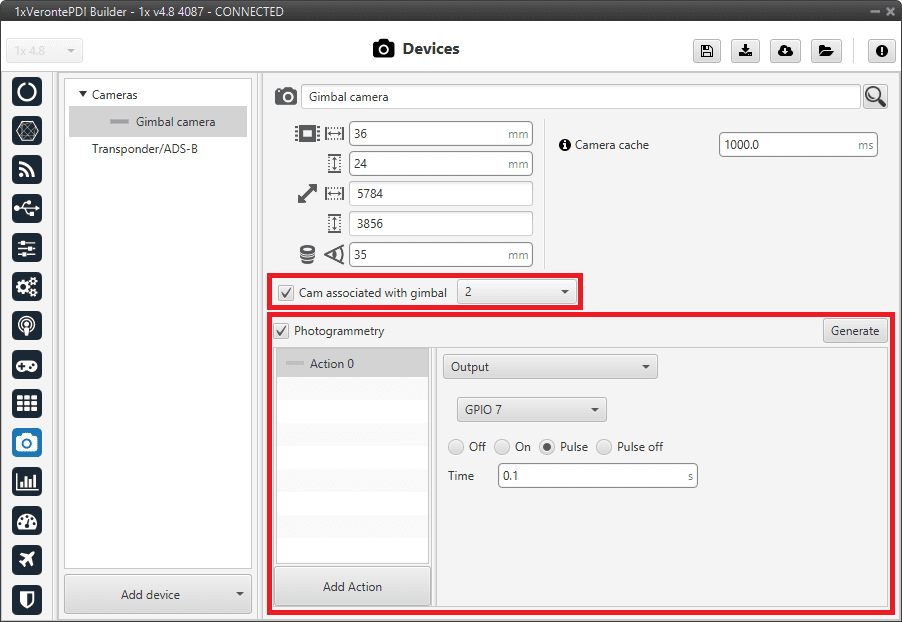
The automation created for Photogrammetry is shown below:
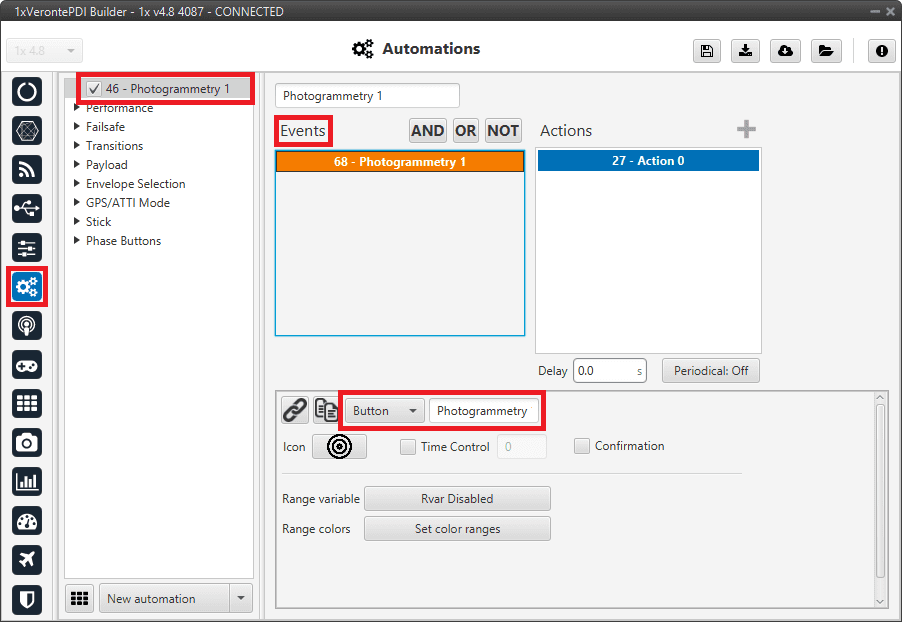
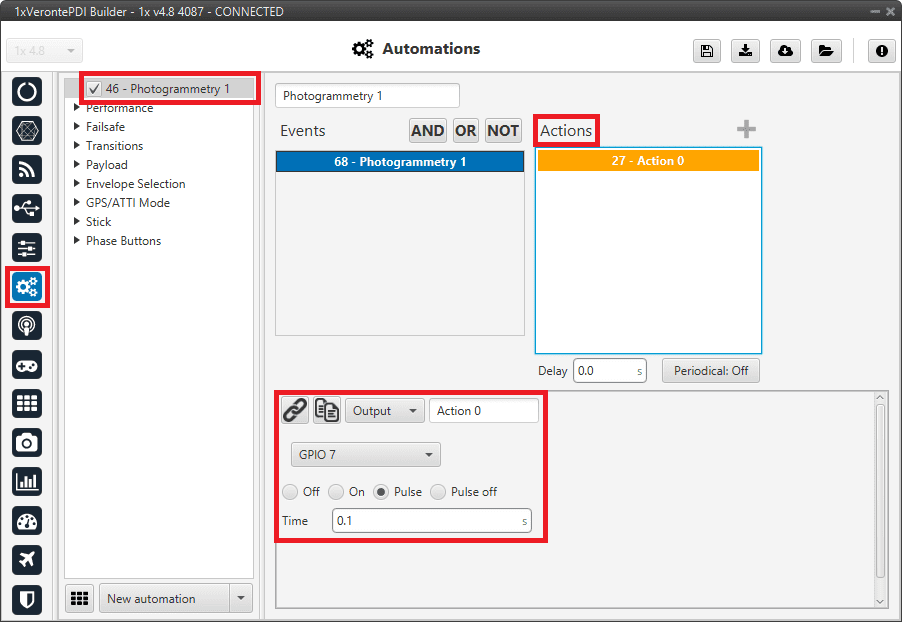
Board
This board menu allows the user to configure communicate via CAN, in 1x PDI Builder, with another device such as CEX, MEX, MC01, etc., in only 1 step, so in only 1 interface window. Instead of doing it in several steps, as is explained in CEX/MEX - Integration examples section or MC01 - Integration examples section.

-
Click on the
 icon to add a new field. The following parameters must be defined:
icon to add a new field. The following parameters must be defined:- Commgr: Select the desired COM Manager port: Commgr port 0-5.
- Can Over Serie: Select the desired Serial to CAN / CAN to serial: CAN Over Serie 0-1 (that is Serial to CAN 0-1 and CAN to serial 0-1).
- Can Input Filter: Select the desired input filter to use: Input filter 0-3.
- Can Output Filter: Select the output filter the user wishes to use: Output filter 0-3.
- Can Port: CAN A, CAN B or BOTH can be selected.
- ID Can Tx: Enter the ID of the CAN message to be sent.
- ID Can Rx: Enter the ID of the CAN message to be received.
Warning
Be careful not to select a producer/consumer that is being used for another purpose, as the configuration defined here has "priority" and will be changed to this.
For more information on these parameters, see Input/Output section of this manual.
-
Clicking the
 icon will remove the field and display a confirmation warning message.
icon will remove the field and display a confirmation warning message. - By clicking on 'Apply changes', all these CAN communication settings are applied to the Autopilot 1x configuration.
Below is an example of before/after when changes are applied:




© 2026 Embention. All rights reserved.